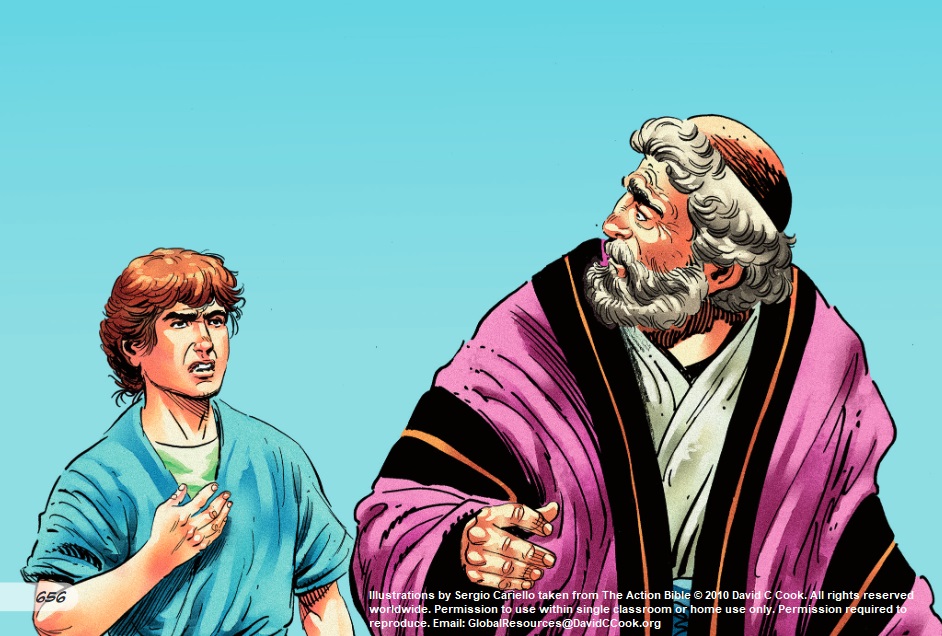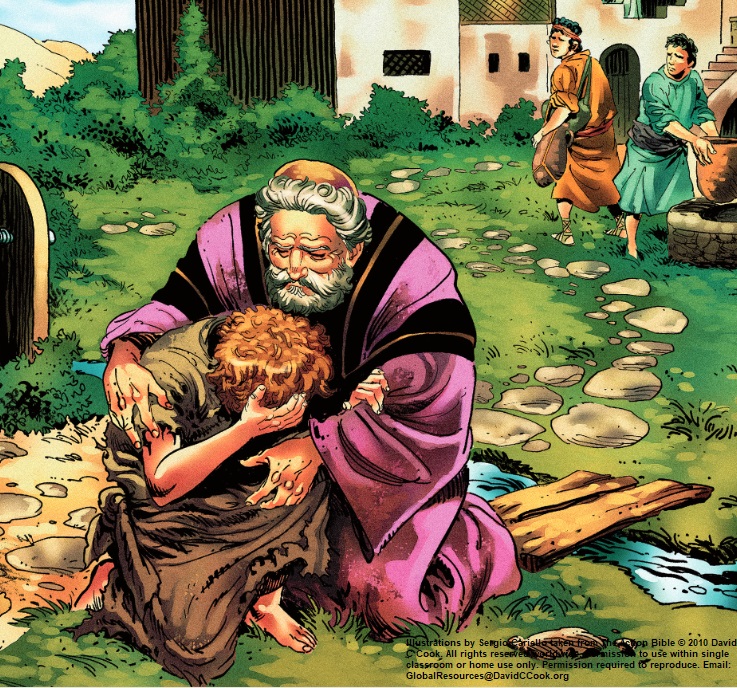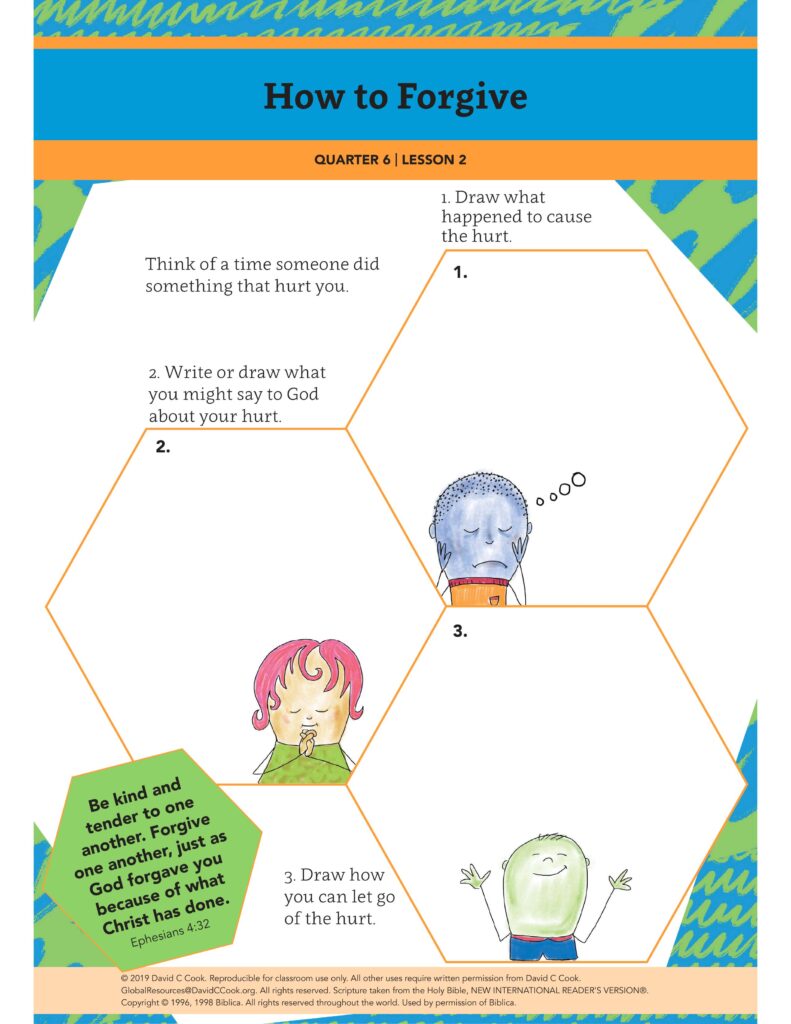During the lesson, the information for you to know is written in regular type, and what we suggest speaking or reading aloud to children is in bold. All resources for this lesson, including the Teacher Guide and Student Page, can be downloaded in a ZIP file by clicking on the following link:
In some lessons you will find "resource articles." These are articles written by experts from around the world to help equip you for your work with children and adolescents. Share them with parents or guardians if you consider it appropriate.
Before class, lay the string or twine on the ground in the middle of your teaching space. For the Connecting activity, the children will be divided into 2 teams. Each team will need a way to keep score by either using a stick in the dirt, paper and a pencil, or chalk and a blackboard.
Be kind and tender to one another. Forgive one another,
just as God forgave you because of what Christ has done.
Ephesians 4:32
When we forgive someone, over time we become tender and kind toward that person. This is not always easy, but God wants us to forgive others. Whether or not we understand an offense committed against us, we can look to Jesus’ example to learn how to forgive others. Human forgiveness is often a process. There are some things that take time to forgive.
Can you think of a time when someone forgave you for a wrong you did? How did it feel to have the person forgive you? Most likely, your relationship with this person was still not perfect, but it was made better by this act of forgiveness. Now think of a time when you forgave someone. What wrong had been done that you needed to forgive? What happened inside you when you forgave him? Hopefully you felt better, lighter, and even peaceful after forgiving this person. God calls us to forgive, but forgiveness is a choice. What will you choose?
Encourage families to talk to their children about a time when they forgave someone. How did they do it? Ask the children to share with their families the 3 ideas about forgiving others from this lesson.
Teacher Tip: If possible, email or text the Family Connection Card to the families of your students.
Welcome the students as they enter. Ask them to form 2 lines, 1 on each side of the line of string or twine. You will want an equal number of children in each team.
There is a line between your teams. Those of you on this side of the line (point to 1 team) will be Team Bird. Those of you on the other side of the line (point to the other team) will be Team Mouse.
In a moment, each member of Team Bird will try to walk along this line. Your goal is to stay on the line as you walk. You will place 1 foot in front of the other to walk down the line. Team Mouse will keep track of the number of times you step off the line. One team member will count each time you step off the line until everyone on your team has walked down the line.
Team Mouse, choose 1 person from your team to keep score. The rest of the team will tell this person when someone from the other team has stepped off the line. Team Mouse will keep score, but they will not use hurtful words to talk to the children on Team Bird.
Give Team Mouse’s scorekeeper the supplies to keep score. Remind her to make 1 mark each time the children from Team Bird step off the line.
Have Team Bird form a line at the end of the string and begin to walk the line. If a child steps off the line, encourage the child to keep trying. Remind Team Mouse to be kind to Team Bird. Once all of the children in Team Bird have walked along the line, ask Team Mouse to call out how many times Team Bird fell off the line.
Now, it is Team Mouse’s turn to try to walk the line without stepping off while Team Bird keeps score.
Have Team Mouse form a line at 1 end of the string. Be sure Team Bird has chosen someone to keep score of the number of times a child steps off the line. Their score should be kept apart from where Team Mouse kept score. After the children in Team Mouse have walked the line, ask Team Bird to call out how many times Team Mouse stepped off the line. Ask the children to take their regular seats for the lesson.
In our game, you kept track of how many times the other team stepped off the line. Counting people’s mistakes or the number of times they hurt other people and do wrong things is not how God wants us to live. When someone does something wrong, God wants us to forgive that person.
Erase all of the scores from both teams.
This is what happens when we forgive. To forgive means you no longer keep track of the wrongs someone has done. You release those wrongs to God. You can ask God to take away any anger and hurt you have in your heart against another person. You may or may not still remember the wrong thing, but forgiveness will help erase the hurt and anger. When you forgive someone, Jesus can wash your heart and erase the bad feelings.
Let’s listen to a story from the Bible to learn more about how to forgive others.
Before beginning this story, choose 2 children. These children will help to act out the story. You will pretend to be the father, 1 child will be the older son, and the other child will be the younger son. Before you begin, tell the child acting out the role of the older son to pretend to work in a field growing and gathering crops each time you mention the older son.
In the Bible, Jesus tells a story that will help us understand how to forgive. There was a man who had 2 sons. The older son worked hard and obeyed his father. The younger son did not want to stay with his father. He asked his father for his share of the father’s land. Without questioning the son, the father gave him half of his property and everything he owned. The younger son took everything he had and left his father.
Which son honoured his father?
How do you think the father felt when his youngest son left home?
Show me with your face an emotion you think the father felt. Very good! If I had been the father, I probably would have felt this way!
The younger son did not have his money for long. He spent all of it on things that were not important and were not good for him. Then there was a famine in that country, which meant that there was no longer enough food to feed everyone! The younger son did not have any money left and could not buy food. He was hungry and had nothing left!
While the older son was still working for his father, the younger son had to get a job feeding pigs. This is what the Bible says happened next:

Read this verse directly from your Bible.
The son wanted to fill his stomach with the food the pigs were eating. But no one gave him anything.
Luke 15:16
The younger son was so hungry when he was feeding the pigs that he wanted to eat the pigs’ food, but no one gave him anything to eat! Everyone rub your stomach to show you are hungry!
How would you feel if you were the younger son?
Responses may include sad and angry, hungry, hopeless, or similar answers.
What do you think the younger son should do?
Allow 2–3 children to respond.
The younger son knew he had not honoured his father. He knew he was wrong for leaving his father’s house. He knew he was wrong for thinking he could spend what his father had given him to make himself happy. He wanted to go home, but he thought his father might not allow this lost son to return home. But he decided to try. He made a plan to tell his father what he had done was wrong and ask for his forgiveness. It was wrong to dishonour his father and God. Not knowing what would happen, the lost son returned to his father.

What do you think happened when the lost son returned to his father?
Allow 2–3 children to respond.
Listen very carefully as I read to you what the father did.
As you read this part, wave to the child playing the role of the younger son and pretend to run and hug him. Act excited and joyful to see him again. Acting out the scene will help the children in your class visualize what happened with the father and son.
While the son was still a long way off, his father saw him. He was filled with tender love for his son. He ran to him. He threw his arms around him and kissed him.
Luke 15:20
Optional: If possible, share the images from The Action Bible. If you are using The Action Bible, read page 602 to the children.

The father forgave his lost son! The father was so loving and kind toward his son that he did not even wait for the son to come to him. The Bible tells us he ran to his son! The father loved him so much, he had a celebration to welcome the lost son home.
Remember the plan the lost son had to ask for forgiveness? He did not even need it. His father already had forgiveness in his heart. While it is important for us and for others to apologize for a wrong that has been done, this does not always happen. Whether we receive an apology or not, it is still important for us to forgive others.
How many times do you think Jesus wants us to forgive others?
Allow 2–3 children to respond. Use 1 of the numbers the children give for the next question.
Is (number) times enough?
Allow the class to respond.
Well, the Bible tells us about a discussion Jesus had with His friend Peter that answers this question. Listen to what Jesus said.
Peter came to Jesus. He asked, “Lord, how many times should I forgive my brother or sister who sins against me? Up to seven times? ”Jesus answered, “I tell you, not seven times, but 77 times.”
Matthew 18:21–22
When we forgive others, we honour God. Peter thought he could stop forgiving a person if that person had been mean to him seven times. Jesus said, no, he must forgive many, many times. Jesus said 77 to show that we are supposed to continue to forgive others. Jesus was saying not to keep track of how many times people hurt you.
Pair up the children for the next activity by going around your space counting off the children—1, 2—then saying, “Pair.” Ask the children to remember their numbers.
Let’s have a race! This is not a running race but a word race. When I say, “Go!” you will race to see how many times you and your partner can forgive each other. The Number 1 partner will say, “I hurt you.” Then the Number 2 partner will say, “I forgive you.” The next time the Number 2 partner will say, “I hurt you,” and the Number 1 partner will say, “I forgive you.” You will continue saying this as fast as you can. Keep track of how many times you say this before I call out, “Stop!” You will have one minute to forgive each other as many times as possible.
Say, “Go!” when you are ready to begin timing the children. After 1 minute, say, “Stop!” Select 1 pair of children to tell you how many times they forgave each other. Ask the rest of the pairs to raise their hands if they forgave each other more times than the first pair. Have the children continue to leave their hands in the air as you call out higher numbers until they hear a number that is higher than how many times they forgave each other. Continue calling out numbers until only 1 or 2 pairs of children have their hands raised.
People will hurt you, and you will hurt other people. To forgive others you must focus on the love of Jesus and ask Him to wash your heart of the hurt and anger that comes when people do mean things.
Forgiveness does not mean that you will forget what happened. Forgiveness means choosing to let go of the wrong done. When someone does something wrong to you, forgiving that person means giving your pain to God. Forgiveness means trusting God to look at what happened and decide the right way to deal with it.
The Bible says God wants you to forgive people when they hurt you. Here are some ideas to help you forgive others:
Let’s think about the story of the lost son.
What did the younger son do to hurt his father? Raise your hand if you can tell me something the younger son did that was wrong.
Call on students who raise their hands. Responses may include that the son did not want to work hard, he was not thankful, he wasted what his father had given him, he ran away.
Let’s think about how you would feel if someone you loved wanted half of what you owned. You give it to that person and he spends all of it on things that are not good for him.
Have the children talk to a partner to answer the questions that follow.
How would you feel?
Would you forgive this person? Why?
Remember, when you forgive someone you can name the wrong that happened, pray to God, and let go of the hurt. Now, show your partner what you would do to forgive someone you loved who spent half of what you owned.
Allow 3–4 minutes to act out how they could forgive someone in this situation.
In the story of the lost son, the father forgave his son because he loved him. God loves you and wants you to forgive others!
Let’s take a moment now to forgive a wrong that was done to us. This is a quiet time for you to talk with God. If you are not ready to release your hurt to God, think quietly about what would help you to forgive. Ask God to help you.
Think about a wrong someone did that hurt you. Make tight fists with your hands (pause for 30 seconds).
Now tell God how that made you feel and ask for His help to forgive. Lift your fists up to the sky (pause for 30 seconds).
Now release the hurt to God by opening your hands. You can ask God to help you release the hurt and anger you feel. It may take some time to completely forgive someone. But you can ask God to help you each time you remember that wrong or your pain and anger (pause for 30 seconds).
As you go through the week, continue to ask for God’s help to forgive those people who have hurt you.
Optional: If you are using Student Pages, give the children crayons to complete their pages. Read the directions and allow the children to fill in each section of the page.

As you work to forgive others, think about what the Bible tells us in our memory verse.
If you are using the Memory Verse Poster, show it to the students.
Be kind and tender to one another. Forgive one another, just as God forgave you because of what Christ has done.
Ephesians 4:32

Do the following motions as you read through the memory verse. Repeat the actions and words with the children 3 times.
End class by saying this blessing, based on Isaiah 43:25, over the children.
Blessing: May you ask the Holy Spirit to help you erase and let go of the wrongs that have been done to you. May you forgive other people just like God forgives you.
Lead the children in singing this quarter’s song, if possible.
Life on Life ©2020 David C Cook. Reproducible for home or classroom use only. All other uses require written permission from David C Cook [email protected]. All rights reserved.